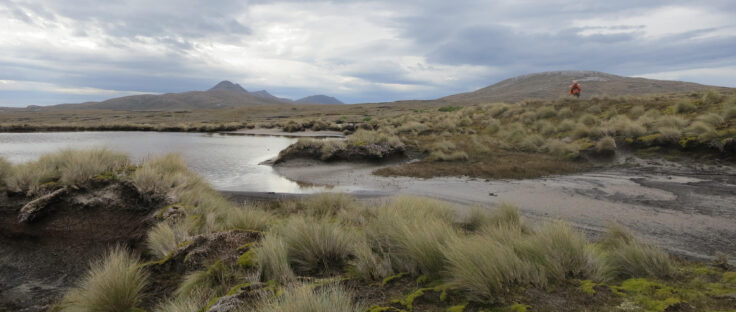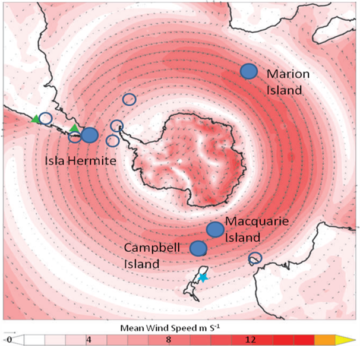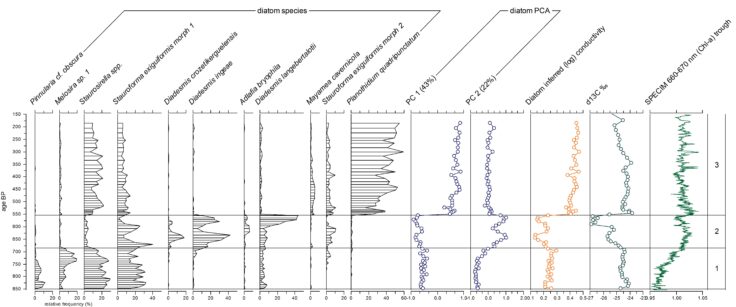Increases in winds weaken Southern Ocean carbon sink
23 July, 2018
A new study of lake sediments from the sub-Antarctic reveals for the first time that increases in westerly winds are likely to reduce the ability of the Southern Ocean to …

In this NERC-funded project, we are generating Southern Hemisphere Westerlies (SHW) proxy records from each of the three major sectors of the Southern Ocean, focusing on subantarctic islands situated in the core belt of the SHW.
We are applying a novel diatom proxy for past wind strength independently controlled by a range of standard sedimentological and biogeochemical proxies. The new proxy is based on the direct transfer of sea spray across the islands by wind, and its effect on the salinity of west coast lakes and ponds. This works on sub-Antarctic islands where there is a marked west-east conductivity gradient in water bodies across the island. This conductivity gradient determines which diatom communities are present in the lakes and can be used to reconstruct changes in conductivity through time, and hence past relative wind strength.
We have demonstrated that this approach works at Macquarie Island, Marion Island, Campbell Island and in the Cape Horn archipelago.
In 2016-2017, on the Antarctic Circumpolar Expedition (ACE), we will visit Marion, Crozet, Kerguelen, Heard, Macquarie, Diego Ramirez and South Georgia Islands to recover more peat and lake sediment records from the core belt of the SHW. Find our project here.


Lake sediment and peat cores provide us with an archive of how an environment has changed over time. Within these sediments, we look at geochemical and sedimentological proxies (e.g. ITRAX, SPECIM, C and N isotopes) and biological records (e.g. diatoms, testate amoebae, pollen) of past climate conditions. These enable us to reconstruct changing lake salinity and westerly wind strength back in time, over millennia. These data will be incorporated into GCM models to develop a better mechanistic understanding of the drivers of SHW evolution.

Interim Director of Science
BAS Science Strategy Executive Group, BAS Management team, Palaeo Environments, Ice Sheets and Climate Change team
Quaternary Geologist
BAS-Arctic Working Group, Palaeo Environments, Ice Sheets and Climate Change team
Dr. Krystyna Saunders, Australian Nuclear Science and Technology Organisation (ANSTO) and the University of Bern
Dr. Wim Vyverman, Dr. Elie Verleyen, Dr. Wim van Nieuwenhuyze, Department of Biology, Ghent University
Dr. Dan Charman, Dr. Angela Galego-Sala, Dr. Matt Amesbury, Dr. Tom Roland, Department of Geography, Exeter University
Dr. Martin Grosjean, Oeschger Centre for Climate Change Research, University of Bern
Dr. François de Vleeschouwer, ECO lab, Toulouse
Dr. Zicheng Yu, Earth and Environmental Sciences, Lehigh University
Dr. Nathalie van der Putten, Dr. Svante Björck, Department of Geology, Lund University
23 July, 2018
A new study of lake sediments from the sub-Antarctic reveals for the first time that increases in westerly winds are likely to reduce the ability of the Southern Ocean to …
Hodgson , D. A., and Sime, L. C. 2010. Southern westerlies and CO2. Nature Geoscience 3, 666-667, doi:10.1038/ngeo970
Saunders, K.M., et al. 2015 A diatom-conductivity transfer function for reconstructing past changes in the Southern Hemisphere westerly winds over the Southern Ocean. Journal of Quaternary Science 30, 464-477
Strother, S.L., et al. 2015. Changes in Holocene vegetation, climate and the intensity of Southern Hemisphere Westerly Winds based on a high-resolution palynological record from sub-Antarctic South Georgia. The Holocene 25, 263-279.
Saunders, K.M., et al. 2012. Late Holocene changes in precipitation in northwest Tasmania and their potential links to shifts in the Southern Hemisphere westerly winds. Global and Planetary Change 92-93, 82-91.